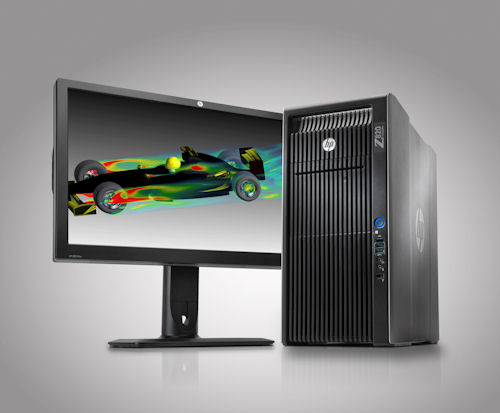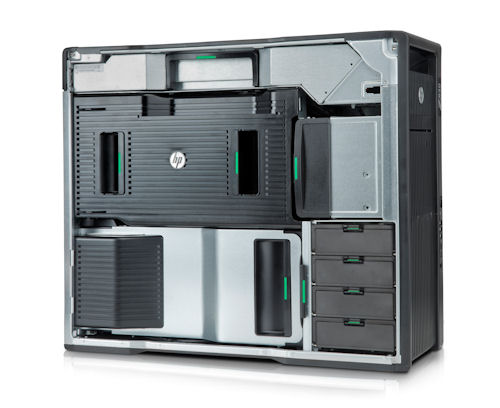HP’s Flagship Engineering Workstation Raises the Bar
HP improves upon its top-of-the-line workstation, the Z820.
Latest News
December 4, 2001
By David Cohn
It’s been more than two years since HP first showed off its Z800, the flagship of its redesigned Z-series workstations (see DE, January 2010). This month, we get a chance to review the Z820, the successor to the Z800.
From the outside, the Z820 looks nearly identical to its predecessor. The only visual difference we could readily see was the inclusion of a conventional 16X SuperMulti DVD+/-RW tray-loading optical drive rather than the slot-loading drive in our original Z800, as well as flat covers over the other two empty 5.25-in. front panel drive bays. A slot-loading DVD drive is available as an option, or you could opt for a tray-loading Blu-ray Disc writer. |
| The new HP Z820 workstation looks nearly identical to the original Z800, with brushed aluminum side panels and integrated handles. Although shown here with a single slot-loading DVD drive, our evaluation came with a more conventional tray-loading drive. |
 |
| Inside, all components are concealed beneath airflow guides. Yet each component “including the power supply “can be easily removed by pulling on green “touch-points.” |
Second-generation CPU
Our evaluation unit came equipped with two new 3.1GHz Intel Xeon E5-2687W CPUs, based on Intel’s latest iteration of its “Sandy Bridge” architecture. This second-generation CPU features eight CPU cores, a 20MB cache, 40 lanes of third-generation PCIe, and a quad-channel memory controller capable of supporting DDR3-1600 memory. The processor provides a maximum turbo boost frequency of 3.8GHz while maintaining a maximum thermal design power (TDP) of 150 watts. The CPUs are backed by an Intel C602 chipset. HP offers a choice of 14 different Intel Xeon processors, including quad-core, six-core and other eight-core CPUs.Half of the 16 dual in-line memory module (DIMM) slots in our unit were filled with 4GB, 1,600MHz DDR3 memory modules, for a total of 32GB of RAM. The Z820 can support up to 512GB of memory. The motherboard also provides expansion options, with three PCIe Generation 3 x16 slots, one PCIe Gen3 x16 slot (x8 electrically), one PCIe Gen3 x8 slot (x4 electrically), one PCIe Gen2 x8 slot (x4 electrically), and a single legacy PCI slot. There are also six USB 2.0 ports on the motherboard. One PCIe x16 slot in our evaluation unit was filled with an NVIDIA Quadro 5000 graphics board with 352 compute unified device architecture (CUDA) cores and its own 2.5GB of dedicated GDDR5 video memory. Because of the width of this board, it blocked access to one of the other PCIe x16 slots. Other boards from both AMD and NVIDIA are also available.Excellent Performance
Because the Z820 marked the first system we’ve tested based on the new eight-core Intel Xeon processors, our expectations were quite high “and we were not disappointed. On the SPECopc Viewperf graphics benchmark, the Z820 equipped with the high-end NVIDIA Quadro 5000 outperformed all systems we’ve tested to date, except those running over-clocked CPUs. It even managed to surpass over-clocked systems on several viewsets.HP Workstation Z820 |
David Cohn is the technical publishing manager at 4D Technologies. He also does consulting and technical writing from his home in Bellingham, WA, and has been benchmarking PCs since 1984. He’s a contributing editor to Desktop Engineering and the author of more than a dozen books. You can contact him via email at [email protected] or visit his website at DSCohn.com.
More Info
HPHP Workstation Z820
- Price: $9,984 as tested ($2,165 base price)
- Size: 8.0x20.7x17.5 in. (WxDxH) tower
- Weight: 58.6 lbs.
- CPU: two Intel Xeon E5-2687W 3.1GHz eight-core with 20MB cache
- Memory: 32GB (512GB max) DDR3 1,600MHz (16 DIMM slots)
- Graphics: NVIDIA Quadro 5000
- Hard Disk: Seagate 300GB 15,000-rpm SAS
- Optical: 16X SuperMulti DVD+/-RW
- Audio: High-definition integrated Intel/Realtek HD ALC262 audio
- Network: dual integrated Intel 82579LM PCIe Gigabit LAN
- Slots: Three PCIe Gen3 x16, one PCIe Gen3 x16 mechanical/x8 electrical, one PCIe Gen3 x8 mechanical/x4 electrical, one PCIe Gen 2 x8 mechanical/x4 electrical, one PCI
- Drive Bays: three external 5.25-in. bays; four internal 3.5-in. bays
- Ports (Front): one USB 2.0, two USB 3.0, one IEEE 1394a (FireWire), one microphone in, one headphone out
- Ports (rear): four USB 2.0, two USB 3.0, one IEEE 1394a (FireWire), one audio in, one audio out, one microphone in, PS/2 mouse, PS/2 keyboard, two RJ-45 to integrated Gb LAN, one 9-pin serial
- Ports (internal): six USB 2.0
- Keyboard: 104-key HP keyboard
- Pointing device: two-button optical HP scroll mouse
Subscribe to our FREE magazine, FREE email newsletters or both!
Latest News
About the Author
David Cohn is a consultant and technical writer based in Bellingham, WA, and has been benchmarking PCs since 1984. He is a Contributing Editor to Digital Engineering, the former senior content manager at 4D Technologies, and the author of more than a dozen books. Email at [email protected] or visit his website at www.dscohn.com.
Follow DE





